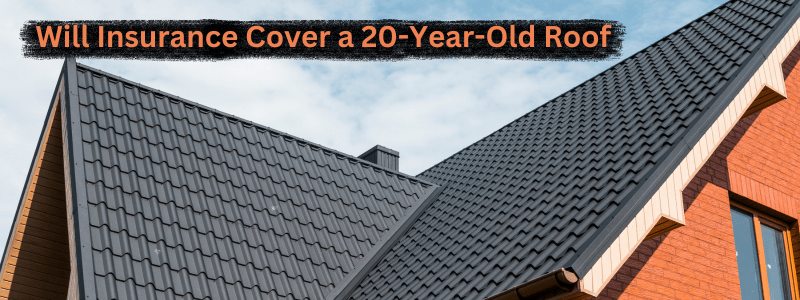
If you own a home with a 20-year-old roof, you might be wondering, Will Insurance Cover a 20-Year-Old Roof? Can your old roof still be insured? What factors do insurers consider? This article delves into the intricacies of roof insurance, particularly for older roofs, and provides you with actionable insights on navigating this often complex topic.
Understanding Roof Insurance
What is Roof Insurance?
Roof insurance is a component of your homeowner’s insurance policy designed to cover damages to your roof caused by various perils such as storms, hail, fire, or other natural disasters. It ensures you are financially protected against significant out-of-pocket expenses for repairs or replacement.
Types of Roof Insurance Policies
- Actual Cash Value (ACV) – Pays out the depreciated value of the roof at the time of the claim.
- Replacement Cost Value (RCV) – Covers the full cost to replace the roof, regardless of depreciation.
- Extended Replacement Cost – Provides additional coverage beyond the RCV if costs exceed the initial estimate.
Common Coverage Options
- Standard Coverage: Protects against common perils like wind, hail, and fire.
- Extended Coverage: May include protection against less common risks like falling objects or the weight of ice and snow.
- Exclusions: Often excludes damage due to wear and tear, neglect, or manufacturer defects.
Factors Influencing Insurance Coverage
Age of the Roof
Insurers typically scrutinize the age of your roof closely. A 20-year-old roof is often seen as a higher risk due to its age and potential for pre-existing damage.
Condition of the Roof
The overall condition, including signs of wear, missing shingles, or structural damage, significantly impacts coverage. A well-maintained roof stands a better chance of being insured.
Maintenance History
Regular maintenance records can be a strong point in your favor. Insurers prefer roofs that have been well taken care of over the years.
Type of Roofing Material
Different materials have different lifespans and durability. For example, metal roofs may have better coverage prospects than asphalt shingles due to their longevity.
Insurance for a 20-Year-Old Roof
Typical Insurance Policies for Old Roofs
Most insurers offer Actual Cash Value policies for older roofs, which means they’ll pay for the depreciated value. Some might still offer Replacement Cost Value policies but with stringent conditions.
Challenges with Insuring an Old Roof
Older roofs pose higher risks for insurers, leading to potential coverage exclusions or higher premiums. The likelihood of hidden damage increases with age, making them less attractive to insure.
Case Studies and Examples
- Case Study 1: A homeowner with a 22-year-old asphalt shingle roof successfully filed a claim under an ACV policy after a severe hailstorm but received a payout far less than the replacement cost due to depreciation.
- Case Study 2: Another homeowner with a 20-year-old metal roof received full coverage under an RCV policy because the roof was well-maintained and documented.
Policy Clauses to Look For
Exclusions Related to Old Roofs
Policies may exclude certain types of damage if the roof is deemed too old or improperly maintained. Always check for specific exclusions related to aging roofs.
Coverage Limits
Insurers might set lower coverage limits for older roofs, reducing the maximum payout you can receive.
Depreciation Clauses
Depreciation can significantly reduce your payout. Understand how depreciation is calculated and how it impacts your coverage.
How to Increase Chances of Coverage
Regular Maintenance Tips
- Inspect your roof twice a year.
- Clean gutters regularly to prevent water damage.
- Replace damaged shingles promptly.
- Keep trees trimmed to avoid branches falling on the roof.
Documenting Roof Condition
Keep a record of all maintenance work and inspections. Photos and receipts can provide evidence of a well-maintained roof.
Choosing the Right Materials
Consider upgrading to more durable materials like metal or impact-resistant shingles, which can enhance your insurance prospects.
Filing an Insurance Claim
Step-by-Step Process
- Assess the Damage: Document the damage with photos.
- Contact Your Insurer: Report the damage and initiate the claim.
- Inspection: An adjuster will inspect the damage.
- Estimate: Obtain repair estimates from contractors.
- Settlement: Review the settlement offer and negotiate if necessary.
- Repair: Proceed with the repairs once the claim is approved.
Common Pitfalls to Avoid
- Failing to document the damage thoroughly.
- Missing claim filing deadlines.
- Not understanding your policy’s terms and conditions.
How to Handle Claim Denials
- Request a detailed explanation for the denial.
- Gather additional evidence and documentation.
- Consider hiring a public adjuster to negotiate on your behalf.
Cost vs. Benefit Analysis
Weighing the Cost of Premiums vs. Benefits
Higher premiums for older roofs might make you question if it’s worth it. Compare the potential payout against the cost of premiums to determine if the coverage is financially beneficial.
Financial Impact of Roof Replacement vs. Repair
In some cases, it might be more cost-effective to replace the roof rather than continually repairing it. Consider the long-term financial impact and the potential for future claims.
Alternative Options if Insurance Denies Coverage
Financing Roof Replacement
Look into financing options like home equity loans, personal loans, or contractor financing plans.
Government Assistance Programs
Some government programs offer grants or low-interest loans for home repairs, including roof replacements.
Roofing Company Payment Plans
Many roofing companies provide flexible payment plans to help spread the cost of replacement over time.
Preventive Measures
Importance of Regular Inspections
Regular inspections can catch small issues before they become major problems, prolonging the life of your roof.
Proactive Repairs and Maintenance
Address minor repairs promptly to prevent them from escalating. Regular maintenance can also keep your roof in better condition for longer.
Seasonal Considerations
Different seasons bring different challenges. Prepare your roof for winter by clearing snow and ice, and in the summer, ensure proper ventilation to prevent heat damage.
Selecting the Right Insurance Provider
What to Look for in an Insurer
- Strong reputation and customer reviews.
- Comprehensive coverage options.
- Competitive premiums and deductible options.
- Responsive customer service.
Comparing Different Insurance Companies
Use comparison tools to evaluate different insurers based on coverage, cost, and customer satisfaction.
Reading Customer Reviews
Check online reviews and ratings to get insights into other customers’ experiences with the insurer.
Renewing Your Policy
When to Renew Your Policy
Review your policy annually and renew it before it expires to ensure continuous coverage.
Changes to Look Out For During Renewal
Insurers may adjust premiums or coverage terms. Review any changes carefully to avoid unexpected gaps in coverage.
Negotiating Better Terms
Don’t be afraid to negotiate for better terms or discounts, especially if you’ve been a loyal customer with a good maintenance record.
Impact of Climate and Location
How Weather Affects Roof Insurance
Areas prone to severe weather may face higher premiums. Insurers consider regional risks when determining coverage.
Regional Differences in Coverage
Coverage options and costs can vary significantly by region. Understand how your location impacts your insurance policy.
Expert Opinions and Advice

Insights from Roofing Professionals
Roofing professionals can provide valuable insights into the condition of your roof and the best materials to use for longevity.
Tips from Insurance Agents
Insurance agents can help you understand your policy better and advise on how to maximize your coverage.
Conclusion
Insuring a 20-year-old roof can be challenging, but it’s not impossible. By understanding your policy options, maintaining your roof, and documenting its condition, you can improve your chances of getting coverage. Remember to review your policy regularly and stay proactive about roof maintenance to avoid costly surprises.
FAQs
1. Will my insurance cover an old roof replacement?
It depends on your policy and the condition of your roof. Some insurers may offer limited coverage or only cover the depreciated value.
2. How can I lower my insurance premiums for an old roof?
Regular maintenance, choosing durable materials, and keeping a good insurance history can help lower your premiums.
3. What happens if my claim is denied?
Request a detailed explanation, gather additional evidence, and consider hiring a public adjuster to negotiate on your behalf.
4. Is it worth it to repair an old roof instead of replacing it?
This depends on the extent of the damage and the long-term costs. Sometimes, replacing the roof can be more cost-effective than continuous repairs.
5. How often should I inspect my roof?
It’s recommended to inspect your roof at least twice a year and after major storms.
For more insights on how to manage your finances effectively, be sure to read our detailed guide on What Is Budgeting and Why Is It Important?.
